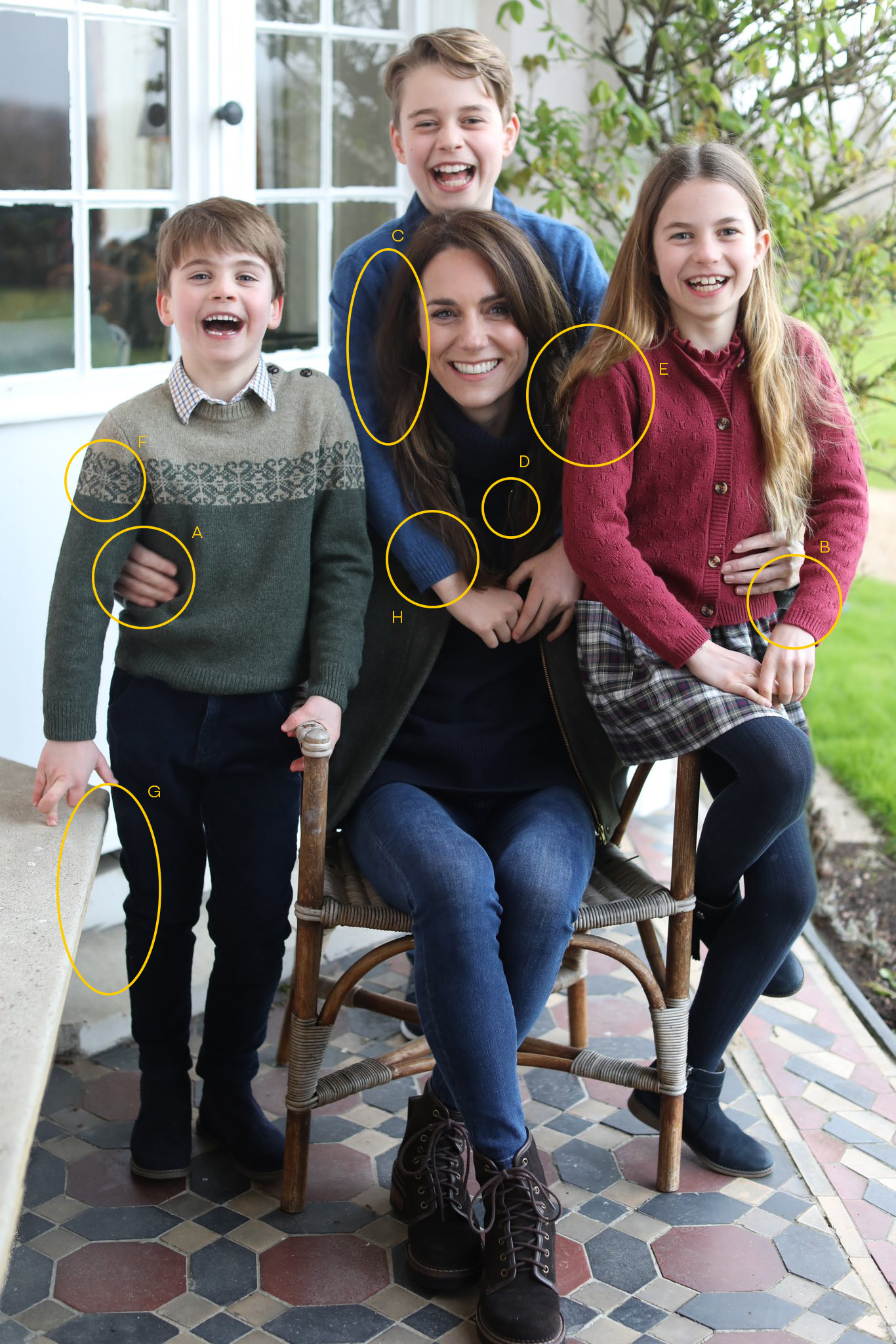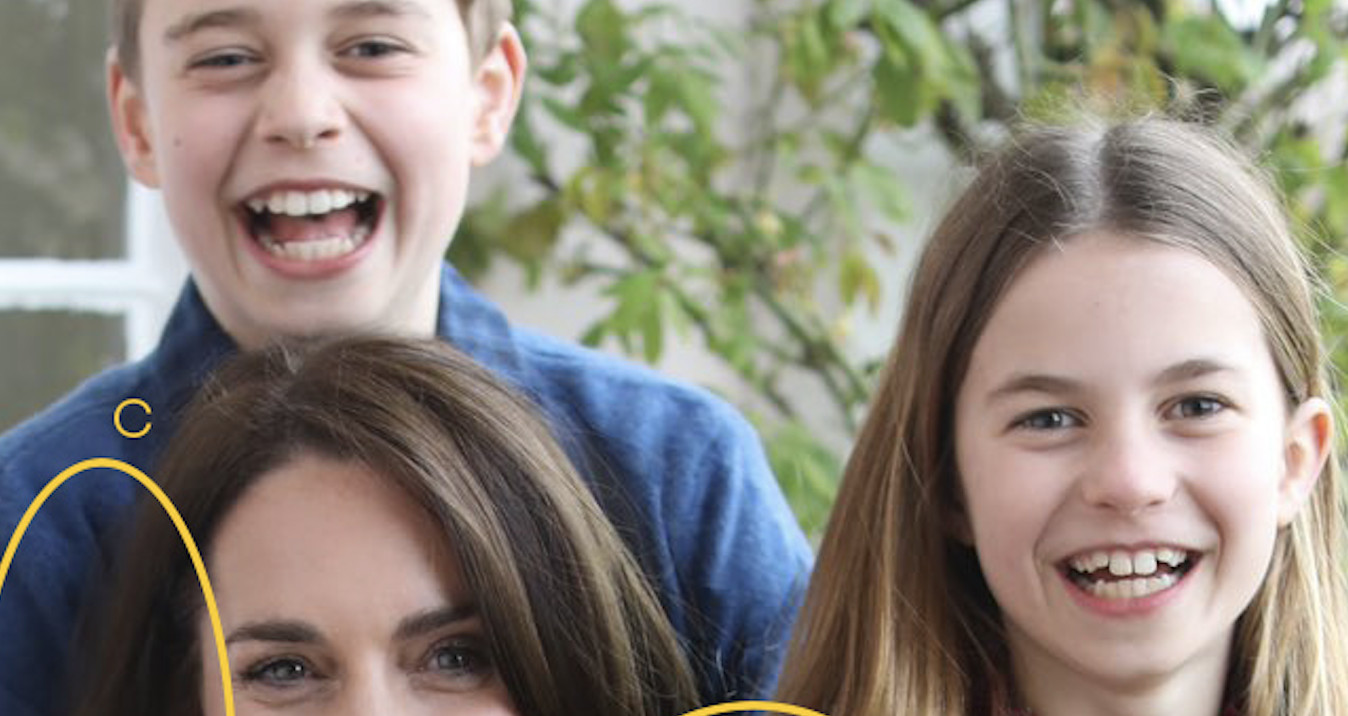What Was Photoshopped In The Royal Photo? The Princess of Wales’s Mother’s Day photo sparked global scrutiny, and at dfphoto.net, we’re diving deep into the digital alterations that caused the controversy, analyzing the image to uncover exactly what was modified and why it matters in the world of visual arts and image authenticity. We’ll explore how digital manipulation impacts perceptions of reality and trust in photography, offering insights for both amateur and professional photographers alike to create transparent and ethical photographic practices.
1. What Initially Sparked Suspicion About the Royal Photo?
The initial suspicions about the royal photo arose due to a combination of factors, including inconsistencies within the image itself and the unusual circumstances surrounding Princess Kate’s absence from public life. The photo, intended to quell rumors about her health, ironically fueled them further.
The AP issued a “photo kill” after detecting manipulations, an extremely rare occurrence. Online observers quickly spotted several oddities: Princess Charlotte’s missing sweater chunk, misaligned patterns, and Kate’s blurry hand. This, coupled with Kate’s absence since January’s abdominal surgery, amplified conspiracy theories, making the poorly edited photo appear as a cover-up.
2. Can You Explain the Streisand Effect in Relation to This Photo?
The Streisand effect perfectly illustrates how the attempt to suppress information can inadvertently amplify it. In this case, the release of a poorly photoshopped image, intended to quell public concerns about Princess Kate, backfired spectacularly.
Rather than reassuring the public, the obvious manipulations drew intense scrutiny. Amateur sleuths dissected every pixel, identifying flaws that would likely have gone unnoticed had the photo not been released. This amplified the story, pushing it into mainstream media and gossip circles, achieving the exact opposite of the intended effect. As Adam Griffin points out, a simple statement or even an older, unaltered photo would have been a better strategy.
3. What Specific Editing Errors Were Identified in the Photo?
Many specific editing errors were identified in the photo, leading to widespread doubt about its authenticity. Here are some key flaws:
- Blurry Right Hand: Kate’s right hand appears strangely out of focus, despite the static nature of the photo, suggesting clumsy retouching.
- Missing Sweater Chunk: A noticeable piece of Princess Charlotte’s sweater is missing, with the area seemingly clone-stamped to cover something up.
- Distorted Wrist: Charlotte’s wrist appears manipulated, almost broken, due to the photo alterations.
- Misaligned Zipper: The zipper on Kate’s jacket is misaligned, indicating where her head was likely stitched onto her neck from a different photo.
- Inconsistent Hair: Kate’s hair lacks a drop shadow, appearing unnaturally blurry compared to the sharp details elsewhere in the image.
- Distorted Sweater Pattern: The pattern on Prince Louis’s sweater is distorted, with misaligned vertical and horizontal strokes.
- Duplicated Tile: A tile near Prince Louis’s foot appears duplicated, revealing a blatant Photoshop error.
- Inconsistent Catch Lights: The catch lights in Kate’s eyes are different in size and shape compared to her children’s, suggesting her face might have been Photoshopped in.
 Photographer Adam Griffin highlighted several editing inconsistencies in the royal family's official photo
Photographer Adam Griffin highlighted several editing inconsistencies in the royal family's official photo
4. Why is Kate’s Blurry Hand a Significant Issue in the Photo?
Kate’s blurry hand is a significant issue because it defies basic photographic principles. In a static photo like this, with everyone sitting still, there’s no logical reason for only her hand to be blurred.
Typically, blur indicates motion captured with a slow shutter speed, but this would affect other elements in the scene. The isolated blurriness suggests the hand was either poorly retouched or added from another image. This inconsistency immediately draws attention and raises questions about the photo’s authenticity. According to Adam Griffin, it appears as if the hand was unnaturally placed there.
5. What Does the Missing Wedding Ring Suggest?
The absence of Kate’s wedding ring initially heightened suspicions, given its iconic status and the public’s familiarity with it. However, this detail alone might not have sparked such widespread speculation.
Coupled with the obvious Photoshop errors, the missing ring fueled theories about the image being a composite or heavily altered. It reinforced the idea that something was being concealed, prompting deeper scrutiny of every other aspect of the photo. While not a definitive proof of manipulation, it contributed to the overall sense that the image was not what it seemed.
6. How Does the Quality of Kate’s Hair Contribute to the Uncanny Valley Effect?
The quality of Kate’s hair in the photo contributes to the uncanny valley effect because it deviates from her typically polished and well-maintained appearance. The blurry, shadow-less hair looks unnatural compared to the crisp details in other parts of the image.
This inconsistency creates a sense of unease, as if something is subtly wrong. Given Kate’s reputation for impeccable grooming, the poorly rendered hair suggests it was lifted from a different, lower-quality source, adding to the perception that her face was Photoshopped in.
7. What is Clone Stamping and How Was It Used (Poorly) in This Photo?
Clone stamping is a Photoshop technique that copies pixels from one area of an image and pastes them onto another. It’s often used for removing blemishes or seamlessly repairing damaged areas.
In the royal photo, clone stamping was used poorly to try and fix errors, particularly around Princess Charlotte’s sweater. The attempt to restitch the missing chunk resulted in a distorted pattern and a blurry texture, making the manipulation obvious. This amateurish use of clone stamping highlighted the lack of professional retouching skills.
8. How Do the Catch Lights in the Eyes Indicate Potential Manipulation?
Catch lights are the reflections of light sources in a person’s eyes. They add life and depth to a portrait, making the subject appear more engaging.
In the royal photo, the catch lights in Kate’s eyes are noticeably different from those of her children. Her catch lights are crisper, smaller, and more defined, while the children’s are softer and less distinct. This discrepancy suggests that Kate’s face, or just her eyes, might have been taken from a different photo with different lighting conditions, contributing to the sense of artificiality.
 The inconsistent light reflections in the eyes of the subjects raise questions about the authenticity of the photo's composition
The inconsistent light reflections in the eyes of the subjects raise questions about the authenticity of the photo's composition
9. What Explanations Are There for Why the Royal Family Would Release Such a Poorly Edited Photo?
Several explanations have been proposed for why the royal family would release such a poorly edited photo:
- Privacy Concerns: They may have wanted to limit access to the original photo to prevent leaks, even if it meant sacrificing quality.
- Kate’s Recovery: Kate’s appearance post-surgery might have been considered unflattering, leading to heavy retouching in an attempt to present a more favorable image.
- Amateur Editing: Kate’s statement that she experimented with editing herself might be partially true, suggesting a lack of professional oversight.
- Control Over the Narrative: By handling the editing internally, they could maintain complete control over the image and the message it conveyed.
Regardless of the reason, the decision backfired, highlighting the importance of transparency and professional expertise in managing public perception.
10. How Does This Incident Affect Public Trust in the Royal Family and Their Communication?
This incident significantly impacts public trust in the royal family and their communication. The poorly edited photo, coupled with the initial lack of transparency, has fueled skepticism and conspiracy theories.
It raises questions about the royal family’s honesty and their ability to manage public relations effectively. Rebuilding trust will require greater transparency and a more strategic approach to communication, especially regarding sensitive matters like health and personal matters. The situation underscores the importance of authenticity in an age of digital manipulation.
11. What Ethical Considerations Should Be Considered When Retouching Photos, Especially for Public Figures?
When retouching photos, especially of public figures, several ethical considerations come into play:
- Transparency: Disclose when and how an image has been altered, especially if it’s meant to represent reality.
- Authenticity: Avoid making changes that fundamentally alter the subject’s appearance or misrepresent the scene.
- Informed Consent: Obtain consent from the subject before making significant alterations to their appearance.
- Respect: Treat the subject with respect and avoid making changes that could be perceived as offensive or demeaning.
- Public Interest: Consider the public interest and avoid using retouching to deceive or mislead the audience.
Balancing aesthetic enhancements with ethical responsibility is crucial, especially when dealing with images that carry significant social or political weight.
12. What Are the Potential Legal Ramifications of Publishing a Manipulated Photo?
The legal ramifications of publishing a manipulated photo can vary depending on the context and the extent of the manipulation:
- Defamation: If the manipulation portrays someone in a false and damaging light, it could lead to a defamation lawsuit.
- False Advertising: Manipulating product photos to misrepresent their features can lead to false advertising claims.
- Copyright Infringement: Using copyrighted images without permission and altering them can result in copyright infringement lawsuits.
- Fraud: Manipulating financial documents or evidence can lead to fraud charges.
- Right of Publicity: Using a celebrity’s image without their consent, even if altered, can violate their right of publicity.
It’s essential to understand the legal implications of image manipulation, especially in commercial or journalistic contexts.
13. How Can Photographers Ensure Their Work is Perceived as Authentic and Trustworthy?
Photographers can ensure their work is perceived as authentic and trustworthy by:
- Being Transparent: Disclosing when and how images have been retouched or manipulated.
- Maintaining Ethical Standards: Adhering to a code of ethics that prioritizes honesty and accuracy.
- Providing Context: Offering background information about the circumstances in which the photo was taken.
- Avoiding Deceptive Practices: Refraining from making changes that fundamentally alter the meaning or integrity of the image.
- Building a Reputation for Integrity: Consistently producing work that is honest, accurate, and reliable.
Trust is a valuable asset for photographers, and maintaining it requires a commitment to ethical practices.
14. What Role Do Photo Verification Tools Play in Detecting Image Manipulation?
Photo verification tools play a crucial role in detecting image manipulation by analyzing various aspects of an image, such as:
- Metadata Analysis: Examining the image’s metadata for inconsistencies or signs of tampering.
- Error Level Analysis (ELA): Identifying areas of an image that have been altered based on compression levels.
- Reverse Image Search: Comparing the image to others online to identify potential sources or alterations.
- Forensic Analysis: Using specialized software to detect subtle signs of manipulation, such as cloning or stitching.
These tools help fact-checkers, journalists, and the public assess the authenticity of images and combat the spread of misinformation.
15. How Can the Public Become More Discerning Consumers of Visual Information?
The public can become more discerning consumers of visual information by:
- Developing Critical Thinking Skills: Questioning the source and purpose of an image.
- Looking for Inconsistencies: Examining the image for obvious signs of manipulation.
- Cross-Referencing Information: Comparing the image to other sources to verify its authenticity.
- Using Photo Verification Tools: Employing online tools to analyze the image’s metadata and integrity.
- Staying Informed: Keeping up-to-date on the latest techniques used in image manipulation.
Education and awareness are key to empowering the public to critically evaluate visual information and resist manipulation.
16. What Are the Best Practices for Ethical Photojournalism in the Digital Age?
Best practices for ethical photojournalism in the digital age include:
- Accuracy: Striving for accuracy in both the content and context of an image.
- Objectivity: Avoiding bias or personal opinions that could influence the portrayal of a subject.
- Transparency: Disclosing any alterations made to an image, beyond basic adjustments.
- Respect: Treating subjects with respect and avoiding sensationalism or exploitation.
- Context: Providing sufficient context to ensure the image is not misinterpreted.
- Verification: Verifying the authenticity of an image before publishing it.
- Accountability: Being accountable for any errors or ethical breaches.
Ethical photojournalism requires a commitment to honesty, integrity, and responsible storytelling.
17. How Do AI-Generated Images Impact Trust in Photography?
AI-generated images pose a significant challenge to trust in photography because they can create realistic-looking visuals that are entirely fabricated.
This makes it increasingly difficult to distinguish between genuine photographs and synthetic creations. The rise of AI-generated images necessitates the development of new tools and strategies for verifying the authenticity of visual content and combating the spread of misinformation. It also underscores the importance of media literacy and critical thinking skills for consumers of visual information.
18. What Are Some Examples of Photo Manipulation Being Used for Political or Social Agendas?
Photo manipulation has been used for political and social agendas throughout history. Some examples include:
- Propaganda: Altering images to demonize enemies or glorify leaders.
- Misinformation: Creating false narratives by manipulating images to support specific claims.
- Censorship: Removing individuals or objects from photos to erase them from history.
- Image Laundering: Cleaning up and distorting images to make them more marketable.
- Fake News: Distributing manipulated images to spread false information and influence public opinion.
These examples highlight the potential for photo manipulation to be used for malicious purposes and the importance of critical evaluation of visual information.
19. What Resources Are Available for Learning More About Photo Verification and Digital Forensics?
Numerous resources are available for learning more about photo verification and digital forensics:
- Online Courses: Platforms like Coursera, edX, and Udemy offer courses on digital forensics and image analysis.
- Workshops and Conferences: Organizations like the International Association of Computer Investigative Specialists (IACIS) and the Digital Forensics Association (DFA) host workshops and conferences.
- Books and Publications: Academic and professional publications cover topics such as image authentication, forensic analysis, and digital investigation.
- Software and Tools: Software like Amped FIVE and FotoForensics provide advanced image analysis capabilities.
- University Programs: Many universities offer degree programs in digital forensics and cybersecurity.
These resources provide valuable knowledge and skills for those interested in pursuing careers in photo verification and digital forensics.
20. How Can dfphoto.net Help Photographers Improve Their Skills and Stay Informed About Industry Trends?
dfphoto.net can help photographers improve their skills and stay informed about industry trends by providing:
- Tutorials and Guides: Detailed guides on various photography techniques, from basic composition to advanced editing.
- Equipment Reviews: Honest and thorough reviews of cameras, lenses, and other photography gear.
- Inspiration: Showcasing the work of talented photographers and providing creative ideas for new projects.
- Community Forum: A platform for photographers to connect, share their work, and ask for feedback.
- News and Updates: Keeping photographers informed about the latest industry trends, technologies, and events.
- Ethical Guidelines: Promoting ethical practices and responsible image creation.
By offering a comprehensive range of resources and tools, dfphoto.net aims to support photographers at every stage of their journey, helping them hone their skills, stay informed, and create impactful images. Visit dfphoto.net at 1600 St Michael’s Dr, Santa Fe, NM 87505, United States or call us at +1 (505) 471-6001 to learn more.
In conclusion, the royal photo incident serves as a stark reminder of the power and potential pitfalls of image manipulation in the digital age. It underscores the importance of transparency, ethical practices, and critical thinking skills for both creators and consumers of visual information. As technology continues to evolve, it’s essential to stay informed, adapt our strategies, and uphold the values of honesty and integrity in our visual communications.
Seeking to enhance your photographic abilities and remain current with industry developments? Explore dfphoto.net for comprehensive tutorials, stunning image galleries, and a vibrant photography community. Enhance your skills, seek inspiration, and connect with fellow photography enthusiasts now!
